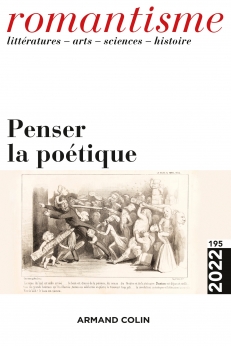
ROMANTISME N°195 (1/2022)
Pour acheter ce numéro, contactez-nous
Recevez les numéros de l'année en cours et accédez à l'intégralité des articles en ligne.
Longtemps tenue pour négligeable, la spatialité propre à la littérature a fortement requis la poétique contemporaine, suscitant de nombreux travaux sur les seuils, la ponctuation, la division des textes et des oeuvres. Appliquées au XIXe siècle, ces approches ont une pertinence spéciale en raison de l’évolution du dispositif des lettres, des interférences entre sphères médiatique et littéraire, de la montée en puissance de l’image et du roman. La question de la découpe que les créateurs se posent à toute échelle (cycle, série, feuilleton, recueil, livre), le lecteur se la pose aussi, et notamment le lecteur critique occupé des questions de composition – notion vénérable à laquelle la poétique du démarcatif, attentive à l’évolution littéraire et à la question des supports, a donné un nouveau fond.
Long considered negligible, the spatiality proper to literature has solicited contemporary poetics with a vengeance, giving rise to a number of studies regarding thresholds, punctuation, the way texts and works divide into sections and parts. When applied to the 19th century, these methods of exploration are particularly pertinent given the evolution of the literary model, the way the media and literature interfere with each other, the rise of visual images and of the novel. The issue of how to partition the text, which creative producers have to ask at any number of scales (novelistic cycle, series, serial publication, anthology, book), also concerns the reader, in particular the critical reader attentive to issues of composition — a venerable concept to which the poetics of frontiers, in its attention to the evolution of literature and the issue of its media, has given a new breath.

